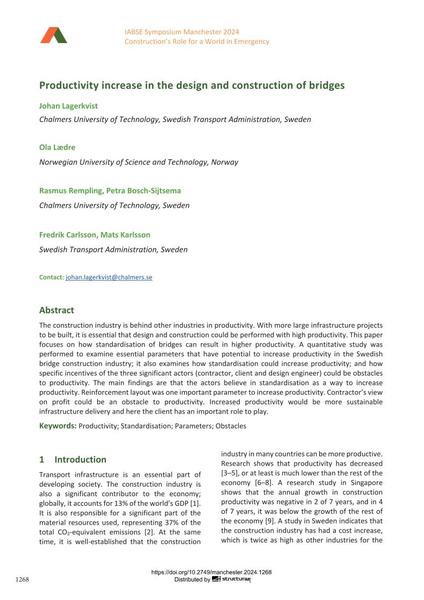Productivity increase in the design and construction of bridges

|
|
|||||||||||
Bibliographic Details
| Author(s): |
Johan Lagerkvist
(Chalmers University of Technology, Swedish Transport Administration, Sweden)
Ola Lædre (Norwegian University of Science and Technology, Norway) Rasmus Rempling (Chalmers University of Technology, Sweden) Petra Bosch-Sijtsema (Chalmers University of Technology, Sweden) Fredrik Carlsson (Swedish Transport Administration, Sweden) Mats Karlsson (Swedish Transport Administration, Sweden) |
||||
|---|---|---|---|---|---|
| Medium: | conference paper | ||||
| Language(s): | English | ||||
| Conference: | IABSE Symposium: Construction’s Role for a World in Emergency, Manchester, United Kingdom, 10-14 April 2024 | ||||
| Published in: | IABSE Symposium Manchester 2024 | ||||
|
|||||
| Page(s): | 1268-1276 | ||||
| Total no. of pages: | 9 | ||||
| DOI: | 10.2749/manchester.2024.1268 | ||||
| Abstract: |
The construction industry is behind other industries in productivity. With more large infrastructure projects to be built, it is essential that design and construction could be performed with high productivity. This paper focuses on how standardisation of bridges can result in higher productivity. A quantitative study was performed to examine essential parameters that have potential to increase productivity in the Swedish bridge construction industry; it also examines how standardisation could increase productivity; and how specific incentives of the three significant actors (contractor, client and design engineer) could be obstacles to productivity. The main findings are that the actors believe in standardisation as a way to increase productivity. Reinforcement layout was one important parameter to increase productivity. Contractor’s view on profit could be an obstacle to productivity. Increased productivity would be more sustainable infrastructure delivery and here the client has an important role to play. |
||||
| Keywords: |
standardisation productivity Parameters Obstacles
|
||||

